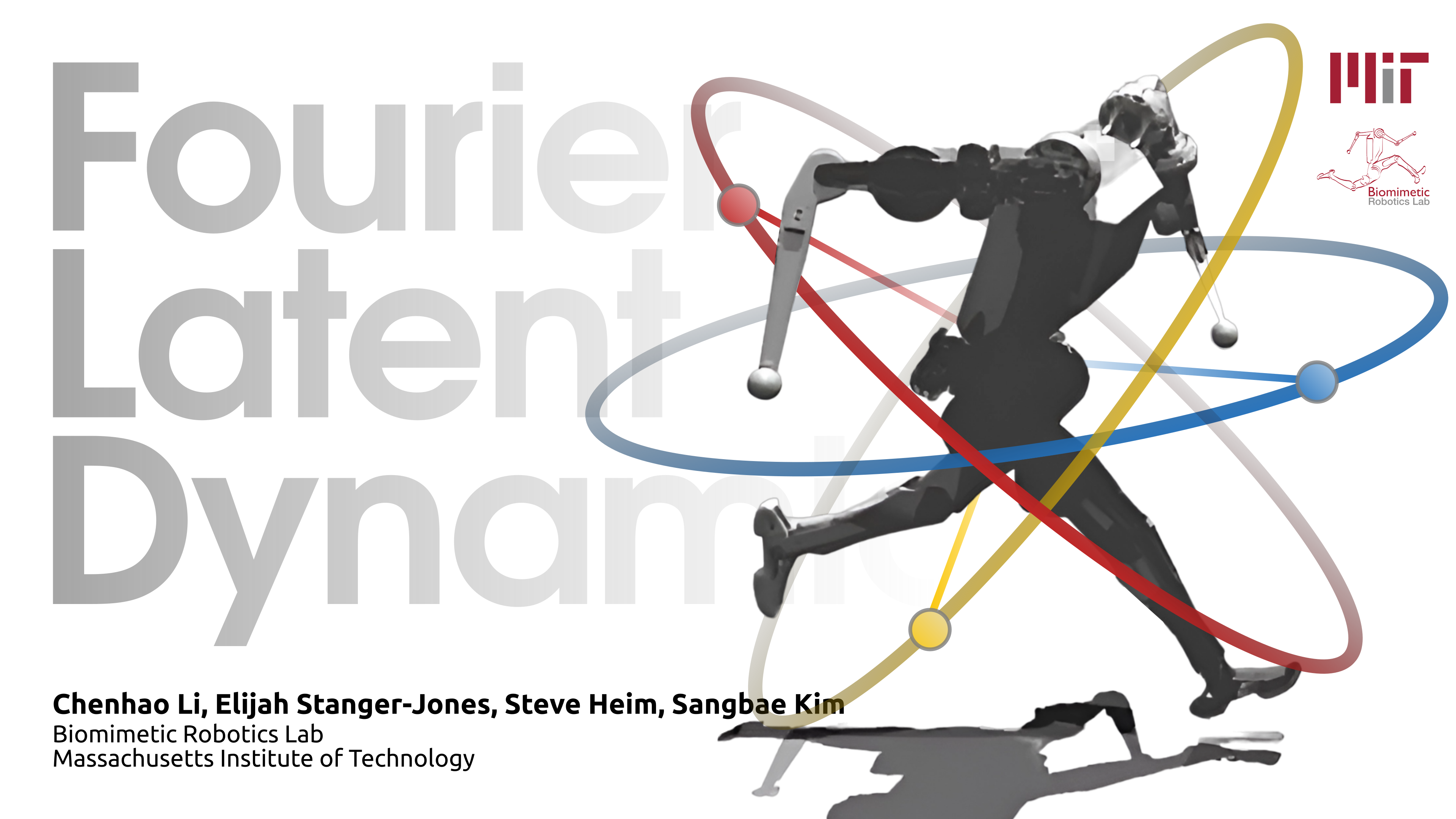This repository provides the Fourier Latent Dynamics (FLD) algorithm that represents high-dimension, long-horizon, highly nonlinear, period or quasi-period data in a continuously parameterized space. This work demonstrates its representation and generation capability with a robotic motion tracking task on MIT Humanoid using NVIDIA Isaac Gym.
Paper: FLD: Fourier Latent Dynamics for Structured Motion Representation and Learning
Project website: https://sites.google.com/view/iclr2024-fld/home
Maintainer: Chenhao Li
Affiliation: Biomimetic Robotics Lab, Massachusetts Institute of Technology
Contact: [email protected]
-
Create a new python virtual environment with
python 3.8 -
Install
pytorch 1.10withcuda-11.3pip3 install torch==1.10.0+cu113 torchvision==0.11.1+cu113 torchaudio==0.10.0+cu113 -f https://download.pytorch.org/whl/cu113/torch_stable.html -
Install Isaac Gym
-
Download and install Isaac Gym Preview 4
cd isaacgym/python pip install -e . -
Try running an example
cd examples python 1080_balls_of_solitude.py -
For troubleshooting, check docs in
isaacgym/docs/index.html
-
-
Install
humanoid_gymgit clone https://github.com/mit-biomimetics/fld.git cd fld pip install -e .
- The workflow consists of two main stages: motion representation and motion learning. In the first stage, the motion data is represented in the latent space using FLD. In the second stage, the latent space is used to train a policy for the robot.
- The provided code examplifies the training of FLD with human motion data retargeted to MIT Humanoid. The dataset of 9 different motions is stored under
resources/robots/mit_humanoid/datasets/misc. 10 trajectories of 240 frames for each motion are stored in a separate.ptfile with the formatmotion_data_<motion_name>.pt. The state dimension indices are specified inreference_state_idx_dict.jsonunderresources/robots/mit_humanoid/datasets/misc. - The MIT Humanoid environment is defined by an env file
mit_humanoid.pyand a config filemit_humanoid_config.pyunderhumanoid_gym/envs/mit_humanoid/. The config file sets both the environment parameters in classMITHumanoidFlatCfgand the training parameters in classMITHumanoidFlatCfgPPO.
python scripts/fld/experiment.py
history_horizondenotes the window size of the input data. A good practice is to set it such that it contains at least one period of the motion.forecast_horizondenotes the number of future steps to predict while maintaining the quasi-constant latent parameterization. For motions with high aperiodicity, this value should be set small. It falls back to PAE whenforecast_horizonis set to 1.- The training process is visualized by inspecting the Tensorboard logs at
logs/<experiment_name>/fld/misc/. The figures include the FLD loss, the reconstruction of sampled trajectories for each motion, the latent parameters in each latent channel along sampled trajectories for each motion with the formed latent manifold, and the latent parameter distribution. - The trained FLD model is saved in
logs/<experiment_name>/fld/misc/model_<iteration>.pt, where<experiment_name>is defined in the experiment config. - The training process is logged in the same folder. Run
tensorboard --logdir logs/<experiment_name>/fld/misc/ --samples_per_plugin images=100to visualize the training loss and plots. - A
statistics.ptfile is saved in the same folder, containing the mean and standard deviation of the input data and the statistics of the latent parameterization space. This file is used to normalize the input data and to define plotting ranges during policy training.
python scripts/fld/evaluate.py
- A
latent_params.ptfile is saved in the same folder, containing the latent parameters of the input data. This file is used to define the input data for policy training with the offline task sampler. - A
gmm.ptfile is saved in the same folder, containing the Gaussian Mixture Model (GMM) of the latent parameters. This file is used to define the input data distribution for policy training with the offline gmm task sampler. - A set of latent parameters is sampled and reconstructed to the original motion space. The decoded motion is saved in
resources/robots/mit_humanoid/datasets/decoded/motion_data.pt. Figure 1 shows the latent sample and the reconstructed motion trajectory. Figure 2 shows the sampled latent parameters. Figure 3 shows the latent manifold of the sampled trajectory, along with the original ones. Figure 4 shows the GMM of the latent parameters. - Note that the motion contains only kinematic and proprioceptive information. For visualization only, the global position and orientation of the robot base are approximated by integrating the velocity information with finite difference. Depending on the finite difference method and the intial states, the global position and orientation may be inaccurate and drift over time.
python scripts/fld/preview.py
- To visualize the original motions in the training dataset or the sampled and decoded motions in the Isaac Gym environment, set
motion_fileto the corresponding motion file. - Alternatively, the latent parameters can be interactively modified by setting
PLAY_LOADED_DATAtoFalse. The modified latent parameters are then decoded to the original motion space and visualized.
python scripts/train.py --task mit_humanoid
- Configure the training parameters in
humanoid_gym/envs/mit_humanoid/mit_humanoid_config.py. - Choose the task sampler by setting
MITHumanoidFlatCfgPPO.runner.task_sampler_class_nametoOfflineSampler,GMMSampler,RandomSamplerorALPGMMSampler. - The trained policy is saved in
logs/<experiment_name>/<date_time>_<run_name>/model_<iteration>.pt, where<experiment_name>and<run_name>are defined in the train config. - To disable rendering, append
--headless.
python scripts/play.py --load_run "<date_time>_<run_name>"
- By default the loaded policy is the last model of the last run of the experiment folder.
- Other runs/model iteration can be selected by setting
load_runandcheckpointin the train config. - The target motions are randomly selected from the dataset from the path specified by
datasets_root. These motions are first encoded to the latent space and then sent to the policy for execution. - The fallback mechanism is enabled by default with a theshold of 1.0 on
dynamics_error.
RuntimeError: nvrtc: error: invalid value for --gpu-architecture (-arch)
- This error occurs when the CUDA version is not compatible with the installed PyTorch version. A quick fix is to comment out decorator
@torch.jit.scriptinisaacgym/python/isaacgym/torch_utils.py.
The ALPGMMSampler utilizes faiss for efficient similarity search and clustering of dense vectors in the latent parameterization space. The installation of faiss requires a compatible CUDA version. The current implementation is tested with faiss-cpu and faiss-gpu with cuda-10.2.
@article{li2024fld,
title={FLD: Fourier Latent Dynamics for Structured Motion Representation and Learning},
author={Li, Chenhao and Stanger-Jones, Elijah and Heim, Steve and Kim, Sangbae},
journal={arXiv preprint arXiv:2402.13820},
year={2024}
}
The code is built upon the open-sourced Periodic Autoencoder (PAE) Implementation, Isaac Gym Environments for Legged Robots and the PPO implementation. We refer to the original repositories for more details.
